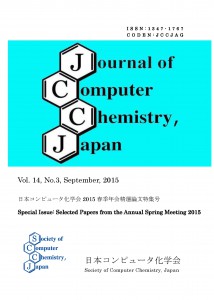 Journal of Computer Chemistry, Japan [No.2015-0031] Published online by J-STAGE
Journal of Computer Chemistry, Japan [No.2015-0031] Published online by J-STAGE<Title:> 分割統治型密度汎関数強束縛分子動力学 (DC-DFTB-MD)法の最近の展開
<Author(s):> 西村 好史, 海寳 丈彰, 中井 浩巳
<Corresponding author E-Mill:> nakai(at)waseda.jp<Abstract:> The authors’ group has developed the program named DC-DFTB-K for the on-the-fly quantum mechanical molecular dynamics (MD) simulation of huge systems using the density-functional tight binding (DFTB) method. The combination with the divide-and-conquer (DC) method enables linear-scaling calculation of DFTB energy and its derivatives. Due to the massively parallel implementation, the program can treat systems containing one million atoms on the K computer. In this paper, the recent extension of DC-DFTB-MD technique is outlined together with the illustrative application to chemical reaction dynamics in lithium-ion device.
<Keywords:> Divide-and-conquer method, Density-functional tight-binding method, Linear-scaling calculation, Molecular dynamics, Chemical reaction simulation, Parallel quantum chemistry calculation
<URL:> https://www.jstage.jst.go.jp/article/jccj/14/3/14_2015-0031/_article/-char/ja/